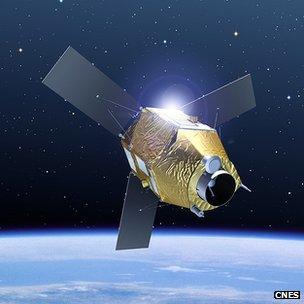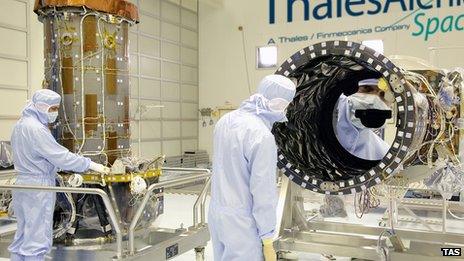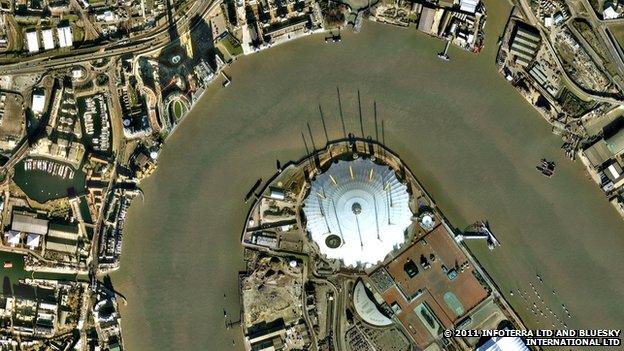Soyuz launches sharp-eyed Pleiades satellite
- Published
The launch of Soyuz rocket carrying six satellites took place in French Guiana
A Russian Soyuz rocket has launched from French Guiana - only the second such vehicle to fly out of the territory's new Sinnamary spaceport.
The Soyuz put six satellites in orbit, including France's new Pleiades-1 high-resolution imaging spacecraft.
This satellite is designed to produce pictures that resolve features on the ground as small as 50cm across.
The capability will put it on a par with the leading US commercial systems operated by GeoEye and DigitalGlobe.
Lift-off occurred on schedule at 23:03 local time, Friday (02:03 GMT, Saturday), with Pleiades-1 being dropped off in its 700km-high polar orbit some 55 minutes later.
The 970kg satellite is the result of a near-decade-long programme in the French space agency (Cnes) to develop one of the most powerful Earth observation systems in the world.

Pleiades-1 will be followed by Pleiades-2 in the coming year
The spacecraft's sensor actually has a resolution of 70cm, but image processing will recover detail that is around the half-metre mark.
Pleiades carries gyroscopes that allow it to swivel its telescope in quick time, enabling it to acquire a strip, or mosaic, of images around its target in a single pass overhead.
The Pleiades spacecraft has been assembled by Astrium, Europe's largest space company, with its instrument supplied by Thales Alenia Space (France).
It will have both a civilian and military role, and a number of European countries (Austria, Belgium, Spain and Sweden) have part-funded the project to get access to its pictures.
Pleiades-1 will be followed by Pleiades-2 on a separate Soyuz launch in 2013.
"The fact that we will have two, twin satellites operating in a phased orbit separated by 180 degrees will give us something very powerful - a daily re-visit capacity. It means we will be able to gather information every day on any part of the globe," explained Charlotte Gabriel Robez, Pleiades project manager with Astrium Geo-information Services.
"This is key because it allows us to tackle applications such as rescue or crisis management, in the aftermath of an earthquake for example," she told BBC News.

The Pleiades programme has been in development for almost a decade
The commercial market for very high resolution imagery has become dominated in recent years by the American companies GeoEye and DigitalGlobe, which benefit from multi-billion-dollar contracts with the US intelligence agencies.
Astrium Geo-information Services is hoping these agencies' voracious appetite for pictures will leave a productive hole in the market for Pleiades' products.
The Soyuz rocket flew its inaugural mission from Europe's Sinnamary spaceport in October. A dedicated new launch pad has been constructed in the Guianese jungle for the Russian vehicle.
By operating closer to the equator, the rocket receives a bigger boost from the Earth's rotation, meaning it can lift nearly double the mass of a comparable payload at its traditional home in Baikonur, Kazakhstan.
The Soyuz' five other "passengers" included a high-resolution imaging satellite for the Chilean military called SSOT; and four radar eavesdropping spacecraft developed for the French military. All six satellites were manufactured by Astrium.

A simulated image of London's 02 Arena. The picture shows the detail Pleiades should be able to retrieve
- Published21 October 2011
- Published18 October 2011